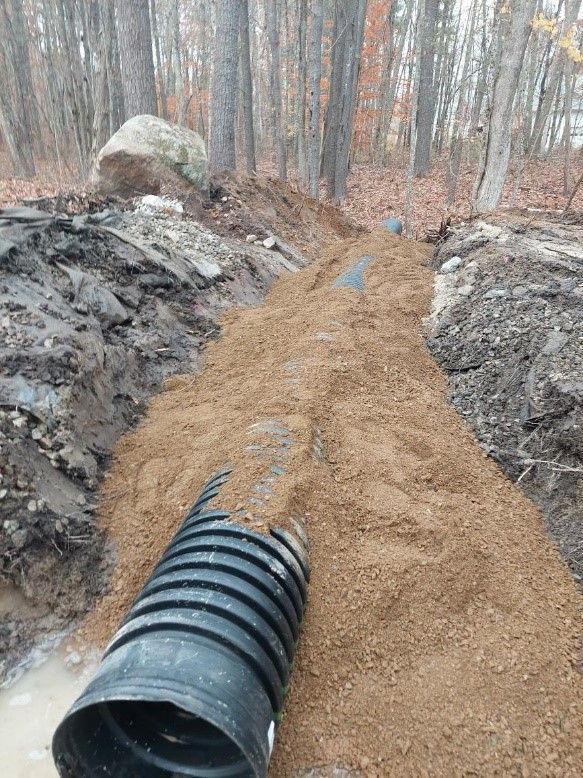Skilled Tree Removal for Home Safety
Skilled Tree Removal for Home Safety
Blog Article
Culvert Installment Facilitated: Step-by-Step Guide for Success
From picking the appropriate culvert dimension to incorporating appropriate drainage procedures, each action in the setup process plays an essential function in the capability and durability of the culvert system. Keep tuned to uncover the necessary actions and considerations that can make culvert installation a smooth and effective endeavor.
Selecting the Right Culvert Dimension
Choosing the ideal culvert size is important for making sure reliable water flow and architectural integrity in culvert installation jobs - Pad Construction. The size of the culvert straight affects the circulation ability of water via the framework. A culvert that is too small can bring about flooding and overflow, while one that is as well huge may result in decreased water rate, potentially creating sediment build-up and clogs
To identify the best culvert size, aspects such as the watershed location, optimal flow prices, and hydraulic efficiency requirement to be very carefully considered. Computations based upon these parameters help in picking a dimension that can effectively take care of the predicted water volume while reducing the danger of blockages and structural failing.
It is necessary to seek advice from design standards and standards to ensure that the picked culvert dimension fulfills the job demands and local laws (Pad Construction). By picking the best culvert size, task supervisors can optimize water flow, avoid possible issues, and enhance the total efficiency and long life of the culvert installment
Preparing the Installment Site
Efficient culvert setup necessitates careful prep work of the setup site to guarantee optimum structural support and capability. Prior to beginning the setup process, it is critical to remove the website of any debris, greenery, or obstructions that can impede the culvert's placement. Guaranteeing a level structure is necessary for the appropriate alignment and stability of the culvert. This may include grading the site to develop a smooth, even surface area that can effectively sustain the weight of the culvert and any awaited lots. Additionally, appropriate compaction of the soil below the culvert is required to protect against clearing up or shifting in time.
Additionally, it is necessary to consider aspects such as soil structure, groundwater levels, and ecological impacts when preparing the installation website. Conducting a complete site assessment can aid identify any type of prospective difficulties or dangers that might influence the culvert's performance. By taking the time to prepare the installment website appropriately, you can help assure a successful culvert installation that fulfills architectural needs and makes sure lasting functionality.
Putting the Culvert Appropriately

The quality at which the culvert is put is important for keeping a proper incline for water circulation. Furthermore, the culvert needs to be oriented correctly to make sure that the inlet and outlet are in the correct places. Pad Construction.
Backfilling and Condensing the Dirt
Proper backfilling and compaction of the soil around the culvert is vital to ensure stability and look here protect against prospective concerns in the future. Once the culvert is properly positioned, the next essential step is to backfill the location around it with appropriate product. The backfill product must be without rocks, particles, and raw material to prevent damage to the culvert. It is advised to make use of granular material such as sand or gravel for backfilling, as it supplies good water drainage and visit the website compaction buildings.
After positioning the backfill material, it is necessary to small it in layers of uniform density. Making use of a compactor or a mechanical meddle, compact the soil delicately to avoid damaging the culvert. Compaction aids in decreasing the chances of negotiation and guarantees consistent assistance around the culvert. It is important to compact the dirt equally on all sides of the culvert to preserve its structural honesty.
Proper backfilling and compaction not just supply security to the culvert however also assist in avoiding soil erosion and maintaining the read the article longevity of the culvert system.
Making Sure Proper Water Drainage Combination
Incorporating effective water drainage remedies plays a critical duty in the general functionality and long life of culvert installations. Correct water drainage combination is necessary for handling water circulation, preventing disintegration, and ensuring the structural stability of the culvert system. To achieve this, it is vital to design a thorough water drainage strategy that takes into consideration aspects such as the volume of water expected, the topography of the area, and the type of soil existing.

Furthermore, integrating features like disintegration control procedures, such as riprap or greenery, can better boost the performance of the water drainage system. By carefully intending and carrying out these water drainage options, culvert setups can operate effectively and hold up against the test of time.
Final Thought
To conclude, appropriate culvert setup is essential for maintaining reliable drainage systems. By choosing the appropriate culvert size, preparing the installation site, positioning the culvert correctly, backfilling and compacting the dirt, and ensuring proper water drainage combination, success can be accomplished. Complying with these actions will assist guarantee the long life and effectiveness of the culvert, ultimately adding to the general success of the drainage system.
Report this page